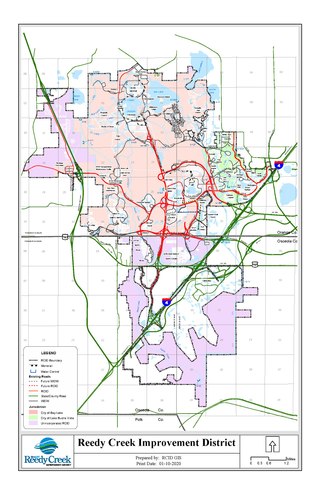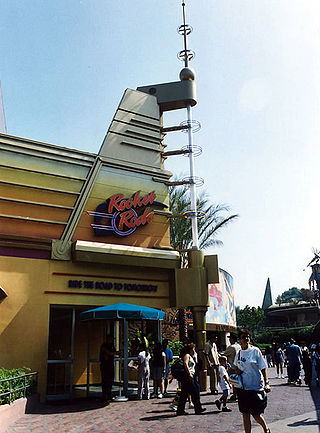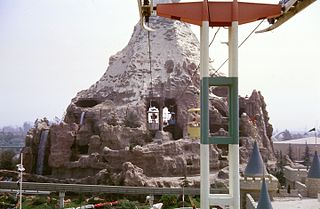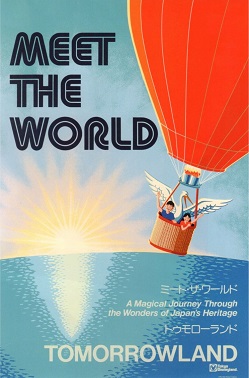
The Central Florida Tourism Oversight District (CFTOD), formerly the Reedy Creek Improvement District (RCID), is the governing jurisdiction and special taxing district for the land of Walt Disney World Resort. It includes 39.06 sq mi (101.2 km2) within Orange and Osceola counties in Florida. It acts with most of the same authority and responsibility as a county government. It includes the cities of Bay Lake and Lake Buena Vista, as well as unincorporated land.

The Walt Disney World Resort is an entertainment resort complex located about 20 miles (32 km) southwest of Orlando, Florida, United States. Opened on October 1, 1971, the resort is operated by Disney Experiences, a division of The Walt Disney Company. The property covers nearly 25,000 acres, of which half has been developed. Walt Disney World contains numerous recreational facilities designed to attract visitors for an extended stay, including four theme parks, two water parks, four golf courses, conference centers, a competitive sports complex and a shopping, dining, and entertainment complex. Additionally, there are 19 Disney-owned resort hotels and one camping resort on the property, and many other non-Disney-operated resorts on and near the property.

Epcot, stylized in all uppercase as EPCOT, is a theme park at the Walt Disney World resort in Bay Lake, Florida. It is owned and operated by The Walt Disney Company through its Disney Experiences division. The park opened on October 1, 1982, as EPCOT Center, the second of four theme parks built at the resort. Often referred to as a "permanent world's fair", Epcot is dedicated to the celebration of human achievement, particularly technological innovation and international culture.

Magic Kingdom Park is a theme park at the Walt Disney World Resort in Bay Lake, Florida. It opened on October 1, 1971, and is owned and operated by The Walt Disney Company through its Experiences division. The official park name has changed slightly over the years, from Walt Disney World Magic Kingdom (1971–1994) and The Magic Kingdom (1994–2017). The park was initialized by Walt Disney and designed by WED Enterprises. The park layout and attractions were based on Disneyland Park in Anaheim, California, and are dedicated to fairy tales and Disney characters.

The PeopleMover, sometimes referred to as the Goodyear PeopleMover and WEDWay PeopleMover, was a transport attraction that opened on July 2, 1967, in Tomorrowland at Disneyland Resort in Anaheim, California. Guests boarded small trains that ran on elevated tracks for a "grand circle tour" above Tomorrowland. The term "people mover", now in wider use to describe many forms of automated public transport, was first coined as the name for this attraction. PeopleMover was originally only a working title, but became attached to the project over time. The attraction was initially seen as a serious prototype for intercity public transport. The ride closed on August 21, 1995, but its station and track infrastructure—which it shared with its short-lived successor, Rocket Rods—remain standing as of 2024. A second PeopleMover opened on July 1, 1975 in Tomorrowland at the Magic Kingdom in Walt Disney World Resort in Bay Lake, Florida near Orlando, Florida, and is still operating today.

Walt Disney's Carousel of Progress is a rotating theater audio-animatronic stage show attraction in Tomorrowland at the Magic Kingdom theme park at the Walt Disney World Resort in Bay Lake, Florida just outside of Orlando, Florida. Created by Walt Disney and WED Enterprises as the prime feature of the General Electric (GE) Pavilion for the 1964 New York World's Fair, the attraction was moved to Tomorrowland at Disneyland in Anaheim, California as Carousel of Progress, and remained there from 1967 until 1973. It was replaced in Disneyland by America Sings in 1974, and reopened in its present home in the Magic Kingdom in 1975.

Walt Disney Imagineering Research & Development, Inc., commonly referred to as Imagineering, is the research and development arm of The Walt Disney Company, responsible for the creation, design, and construction of Disney theme parks and attractions worldwide. The company also operates Disney Live Entertainment and The Muppets Studio and manages Disney's properties, from Walt Disney Studios in Burbank to New Amsterdam Theatre and Times Square Studios Ltd. in New York City. Founded by Walt Disney to oversee the production of Disneyland, it was originally known as Walt Disney, Inc. then WED Enterprises, from the initials meaning "Walter Elias Disney", the company co-founder's full name. Headquartered in Glendale, California, Imagineering is composed of "Imagineers", who are illustrators, architects, engineers, lighting designers, show writers and graphic designers.

The PeopleMover is an attraction in Tomorrowland in the Magic Kingdom at the Walt Disney World Resort in Bay Lake, Florida just outside of Orlando, Florida. Designed as an urban mass-transit system of the future, vehicles take passengers on a grand circle tour of the realm of Tomorrowland that provides elevated views of several other attractions.

Rocket Rods was a high-speed thrill attraction located in Tomorrowland at Disneyland, Anaheim, California. The ride was themed around a hypothetical “drag race” of the future, as well as a futuristic rapid transit system. The ride opened in May 1998, utilizing the existing PeopleMover track and infrastructure as part of the New Tomorrowland refurbishment project. Plagued from its inception with technical problems and mechanical repairs, Rocket Rods was shut down indefinitely for renovations in September 2000; ultimately, the ride would be fully shut down, as confirmed via an official press release in April 2001, after two years of sporadic operations. While Rocket Rods' queue was replaced with the Toy Story-themed dark ride Buzz Lightyear's Astro Blasters in 2005, the majority of the track infrastructure utilized by both the attraction and its predecessor still sit, visibly derelict, throughout Tomorrowland as of 2024.

Tomorrowland is one of the many "themed lands" featured at all of the Magic Kingdom styled Disney theme parks around the world owned or licensed by The Walt Disney Company. Each version of the land is different and features numerous attractions that depict views of the future. Disneyland Park in Paris includes a similar area called Discoveryland, which shares some elements with other Tomorrowlands but emphasizes visions of the future inspired by Jules Verne.

Horizons was a dark ride attraction at Epcot, a theme park at Walt Disney World in Bay Lake, Florida. Located on the eastern side of the Future World section of Epcot, the attraction used Disney's Omnimover system, but unlike most omnimover systems, it was suspended from a track above, which took guests past show scenes depicting visions of the future. It is believed to be the sequel to Walt Disney's Carousel of Progress, an attraction in Tomorrowland at Walt Disney World's Magic Kingdom. Horizons was the only attraction in Future World to showcase all of Epcot's "Future World" elements: communication, energy, transportation, anatomy, along with humankind's relationship to the sea, and the land.

The Walt Disney World Monorail System is a public transit monorail in operation at the Walt Disney World Resort in Bay Lake, Florida, near Orlando. The resort operates twelve Mark VI monorail trains on three lines of service. The monorail system opened in 1971 with two routes and with Mark IV monorail trains. It was expanded to three lines in 1982, and the rolling stock was updated to Mark VI trains in 1989.

The Skyway was a gondola lift attraction at Disneyland, at the Magic Kingdom, and at Tokyo Disneyland. Since all versions of this attraction took riders back and forth between Fantasyland and Tomorrowland, the route from Tomorrowland was called Skyway to Fantasyland, and the route from Fantasyland was called Skyway to Tomorrowland.

The Astro Orbiter is a "rocket-spinner", aerial carousel-type attraction featured at five Disneyland-style parks and Walt Disney Resorts around the world, except for Tokyo Disneyland. Although each ride may have a slightly different name, all share the same experience of vehicles traveling through space, spinning around a central monument. In most forms of the ride, the use of a joystick enables guests to adjust the height of their individual cars at will, usually within a range of no more than 10-15 feet. When the ride cycle comes to its completion, any ascended vehicles are automatically lowered for passenger exit and re-boarding. Over the years, with each new iteration of the ride debuting, new designs, thematic schemes, and locations have been implemented to fit with the changing themes of several Tomorrowlands.

Meet the World was an attraction at Tomorrowland in Tokyo Disneyland that operated from 1983 until 2002. It was a show that explored the history of Japan over the course of 19 minutes, focusing specifically on the history of Japan's engagement with the outside world. The show featured an animated crane explaining Japanese history to a young boy and girl from Yokohama. The show featured dialogue between a number of audio-animatronic figures and a movie screen in the background. Park guides and maps said "explore Japan's heritage in an incredible time-travel adventure!"
Mission to Mars was an attraction located in Tomorrowland at Disneyland and at Walt Disney World's Magic Kingdom. It originally opened as Rocket to the Moon at Disneyland in 1955, and as Flight to the Moon in Walt Disney World on Christmas Eve 1971, before it was retooled to the Mars version in 1975. It then closed down in 1992 and 1993, respectively. The attraction simulated taking guests on a space trip to the Moon or Mars.
"There's a Great Big Beautiful Tomorrow" is the theme song to two Disney attractions, Walt Disney's Carousel of Progress at the Magic Kingdom of Walt Disney World and Innoventions at Disneyland. It was also used in one scene of the Epcot attraction Horizons.

The Mark IV monorail (Mk4) was a straddle-type monorail train built for the Walt Disney World Monorail System. The design was developed by Disney Imagineer Bob Gurr. Ten trains were built by Martin Marietta in 1969 at the cost of about $7 million USD each and they were used on the monorail system between 1971 and 1989 before being replaced by the Mark VI monorail, although a few lasted until 1991.

Innoventions was a two-story exhibit in Tomorrowland at Disneyland in Anaheim, California. Opening on July 3, 1998 as part of the New Tomorrowland, it featured rotating exhibits focusing on near-futuristic technologies. The attraction operated for nearly 17 years, closing on March 31, 2015. It occupied the Carousel Theater, a round two-story building in which the outer half of the first floor rotates. A similar attraction of the same name existed in Epcot at the Walt Disney World Resort until 2019.
Tomorrowland may refer to:



















